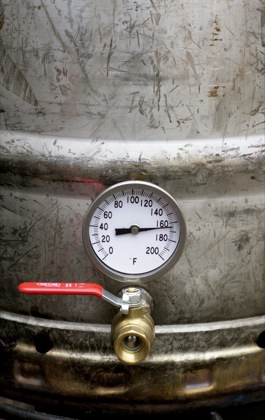The allure of leaping into all-grain brewing is all too often discouraged by unnecessary trepidation. There is the notion that is it cluttered with calculations and technical expertise, coupled with an air of alchemy and magic. It takes a little of both, but isn’t nearly as unforgiving and complicated as it seems, and in fact, can become rather routine and simple after just a few batches.
It’s definitely for you if you can handle moderate complexity, adapt on the fly, and are resourceful and energetic (all attributes of the average hobbyist). All-grain brew is only inherently better than extract if done well. The advantage to brewing from scratch is entire process control and unlimited flexibility. Cloning favorites and personalizing brews is the pinnacle of reward.
There is a certain rhythm to brewing, and once that is mastered you will be amazed at the amount of down time.
From a procedural standpoint, all-grain brewing does have some potential stumbling blocks, as even the most grizzled veterans will admit, but the key to immediate success is to concentrate on the salient issues, those sequential bullet points that help ensure a triumphant session. The minutiae, experimentation and tweaking can come later.

For the first few batches, you can easily hit the touchstones that will not only offer clear sailing, but offer a solid foundation for future batches. Following is a bucket list of brewing checkpoints, if you will, that will serve to build your skill and knowledge, brick by delectable brick, by helping you avoid the most aggravating, head-banging mistakes of all-grain brewing and help make that first batch a rousing success.
The Strategy
Have a good idea going into all-grain about what it entails by watching an experienced brewer ply his craft and doing some reading. How To Brew by John Palmer and The Complete Joy of Homebrewing by Charlie Papazian are definitive and indispensable reference manuals. There is a certain rhythm to brewing, and once that is mastered you will be amazed at the amount of down time. Make sure you have all of the equipment at hand and functioning properly ahead of time. Get a second thermometer―they break―and use it without restraint: it only takes a few seconds to monitor your containers.
The Recipe
For the first few batches, make something predictable and simple, from a trustworthy source. There is a tendency among brewers to get too complicated too soon. This really doesn’t have much to do with untangling brew day, but a bare-bones formulation will allow you to critique your results more easily. A grist of two malts, one or two hop varieties, and hop additions for bitterness, flavor, and aroma pretty much cover everything. Learn how to calculate IBUs and study malt characteristics: poorly balanced beers won’t impress anybody.










Thanks for this in-depth breakdown and instructions. I am going to use this as a manual for my next all-grain brew. There were several steps you mentioned that I did not take, and will definitely heed on my next batch. Thanks again, great article!